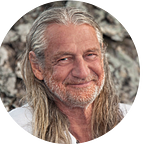The Asana Files: Trikonasana as Strength-Receiving | Mark Whitwell
Tirumalai Krishnamacharya’s life represents a bridge between ancient past and modern present. Born in 1888 and dying only recently in 1989, he was the vehicle by which the physical wisdom practices of Yoga entered modern India and then the world.
After spending seven and a half years at Mount Kailash with his guru Ramamohan Brahmachari, he returned home and began to teach. He was teacher to the most prominent figures of 20th century Yoga: B.K.S. Iyengar, Pattabhi Jois, Indra Devi, and his son TKV Desikachar.
Krishnamacharya taught Yoga as the union of opposites: as each person’s perfect participation in the male-female harmony that is nature of Life Itself. The principle means of this participation is the breath.
The exhale carries the male principle of strength and the ascending life-current. Whereas the inhale carries the female principle of receptivity and the descending life-current. The exhale moves up from the body base; the inhale moves down the soft, feeling frontal line.
When we merge the two in our sadhana we feel into and enjoy the male-female union; the harmony of strength and receptivity that is our exquisite animal inheritance; a profound intelligence how our body-mind is functioning.
Beyond our own form, we can see the same principle manifesting in nature. A tree, for example, is the union of a strong ascending trunk with a deliciously soft foliage of leaves. In this union, the trunk supports the leaves and the leaves support the trunk to receive the energy of the sun.
Our ancestors recognised the union of strength and receptivity was the very nature of Reality Itself. And so, asana was developed over millennia as the practical means by which any person could participate directly in the absolute condition of Reality Itself. Happiness arises when we relax into the reality of our Natural State.
For the publication of his 1934 book Yoga Makaranda, Krishnamacharya took steps to document right asana practice in a time when photography was very expensive. This was not about an idea of a perfect, ideal posture but more a visual representation of what asana looks like when it is practiced as the perfect union of the male-female aspects.
In trikonasana, keep equal weight through the front of each foot with the toes active. Muladhara bandha and Uddiyana bandha will be there naturally when the body base and the belly is drawn in and up on the exhale.
We participate in a column of breath: above to below, strength-receiving, the male-female collaboration. The head and eyes can turn to the hand above on an exhale. On an inhale, the chest can open and the twist can be relaxed so that the descent of the inhale has room to permeate the whole-body.
The quality of strength-receiving in asana are not an ideal to reach for. It is already how your whole body is functioning. We simply participate in what is already happening. We stop interfering with the natural state of the body with our culturally programmed mind. We do this by letting the breath guide all asana.
“When practising asana, the breath that is inhaled into the body and the breath that is exhaled out must be kept equal. Moreover, practise the asana with their vinyasas by breathing only through the nose.
Just as music without sruti and laya will not give any pleasure, similarly asana practice done without vinyasa krama will not give good health. When that is so, what more is there to say about long life and strength in this context?” — Yoga Makaranda (1934)
The open secret of the Yoga tantras that Krishnamacharya passed on is that the breath must be the central feature of the asana, its very purpose in fact. By ensuring that the inhale is at least fifty percent of the asana we make sure there is an equal amount of receptivity relative to the amount of strength.
And by letting the breath initiate and envelop the movement, the mind has no choice but to follow the breath. As a result, the mind becomes linked to the intrinsic intelligence of the body.
When we published such photographs of Krishnamacharya in The Heart of Yoga (1995) the students of the popular styles could not see the significance of the “no drama” in his body. People had been programmed to be dramatic and strong only.
The young men who popularised Yoga in the west did not include the breath principles that Krishnamacharya brought forth from the wisdom traditions of the tantras. The union of opposites was abandoned as the worldwide cult of male force only reconstituted these practices in its own image.
Yet to do asana without an equal emphasis on inhalation only wears out the body. Strength that does not receive eventually destroys itself. Of course, this is the problem of humanity.
Every body has been programmed by male orthodoxy to only be strong, to acquire, and to control. It is this patterning that is wrecking the planet. It is a gross, utterly unnecessary imposition on the natural sublimity and power of Life Itself.
In my life of teaching what Krishnamacharya actually taught, I have seen many friends fall out of these destructive patterns of male force only. When we merge the inhale with the exhale in the asana’s that are right for our body-type, the nurturing intelligence of Life moves through the body-mind.
Life removes everything that it does not need. We cannot force this process (no struggle!): it happens naturally in unpredictable and organic ways; but it does happen. What remains is the body as it always was and is: strength-receiving — that which is already the case.
